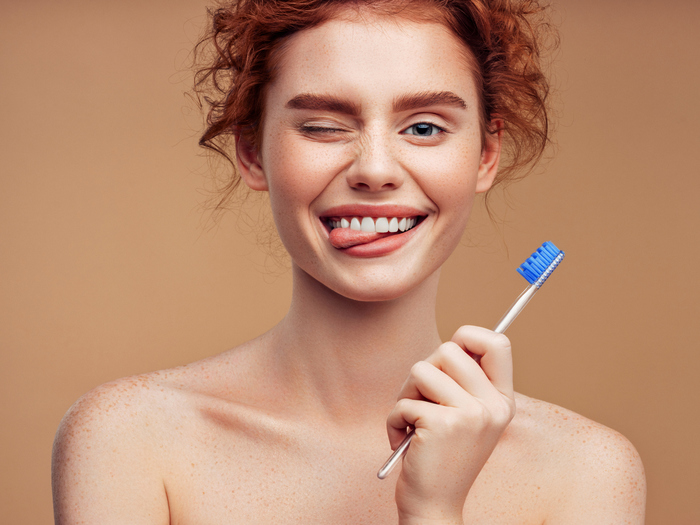Once upon a time there was the toothbrush, and the fluoride toothpaste.
After many years of
oral care
always done in the same way, the sector is undergoing a transformation.
If the way of
smart toothbrushes
is already leveled and on the market there are hybrid accessories for cleaning teeth such as handpieces equipped with electronic brushes and coordinated with special apps on the smartphone to monitor the type of cleaning and antibacterial efficacy, the rising trend of changing toothpastes is less noticeable, always simply with mint. Cleaning and refreshing the mouth is not enough, research produces new functions: from the most marked antibacterial effects that respect the oral microbiome to alcohol free toothpastes, without additives or vegans, rich in calcium, gluten free and, again, sugar free and with recyclable packaging. Research is also committed to
avoiding microplastics
enemies of the environment, usually contained in 60% of common toothpastes and toothpastes and mouthwashes in tablets to dissolve in the mouth and with little water (such as those of the English ethical brand
Lush
, among others)
are widespread and
thus avoid packaging.
Also new is the green turning point that sees the return of tooth cleaning systems borrowed from millenary traditions such as Ayurvedic and the use of natural materials such as
bamboo
or a non-disposable plastic in the handle but only in the
interchangeable head.
Even dental floss is updated: in recyclable plastic and whitening vegetable black carbon.
Cosmetic & Toiletries Science Applied magazine has dedicated a focus to oral hygiene innovation in which the authors are the first to declare themselves surprised by the many changes taking place.
At the latest CES technology fair in Las Vegas, a toothbrush, the
Plaqless Pro (Colgate),
was awarded for innovation
.
Super technological, electronic, it is able to detect the accumulation of biofilm (bacterial plaque) in the mouth through sensors.
The cleaning accuracy is checked in real time on the smartphone through an APP that connects directly with the toothbrush through a Bluetooth connection.
Presented at Ces in Las Vegas and direct competitor, the new
Oral-B iO
electric toothbrush
with six years of research behind it
has a magnetic drive system, micro-vibrations and pressure sensors
.
Connected with a special App, it recognizes the areas inside the mouth and guides the correct and complete brushing of all areas.
3D.
16: the areas of the mouth recognized by AI Brushing Recognition technology and reproduced by 3D graphics in the Oral-B app, 7 smart modes to customize brushing: daily cleaning, sensitive teeth, gum protection, deep cleaning, whitening, tongue cleaning, ultra sensitive teeth .
Will it be the year of smart brushes?
Hand in hand with innovation, there is also a strong desire for nature and love for the environment, so much so that among the oral hygiene trends there is a return to alternative, 100% natural cleaning systems.
Right now most brands are launching into the production of toothbrushes made with recyclable, recycled or natural materials such as bamboo and ecological charcoal bristles that also perform a whitening function.
Oil pulling is a real
fashion
, an ancient Ayurvedic procedure that consists of oral rinses made with vegetable oils such as sunflower, sesame or
coconut
for cleansing and purifying purposes.
Disclosed by celebrities such as naturist Gwyneth Paltrow and actress Shailene Woodley, oil pulling is gaining momentum, renowned for over 20 years
Ringana
tooth
oil
for rinses to do in the morning on an empty stomach to cleanse the body and for oral health.
Contains natural silicic acid granules and therefore removes plaque in a completely delicate way.
Selected active ingredients such as Java turmeric, star anise oil, cinnamon oil and eucalyptus oil keep the microflora healthy and have an antioxidant action.
In terms of toothpastes and mouthwashes, all still with fluoride (from the stannous fluoride of the renowned Crest of the sixties, to the turning point of the eighties with fluorine salts and sodium monofluoro phosphate which in contact with saliva releases ions that strengthen the teeth), consumer tastes diversify and 66% of new launches see new references to vitamins and minerals (66%).
55% is instead refreshing for the breath, 36.66% whitening.
This is followed by (about 30% of the novelties) the new botanical and herbal, antibacterial products for sensitive teeth.
There are also new preferences for
products without alcohol
(15.47%), without preservatives or additives (11.69%), for children (11,335), vegans (10.34%), green and made with recyclable materials (10 % but, for the UK market the percentage rises to 34%).
Finally, the toothpastes that respect animals, those with added calcium, gluten free, organic, sugar-free and vegetarian.
For all attention to the microplastics of cleaning products with microgranules.
Instead, the love for the refreshing aroma of mint resists, attesting that tastes in terms of flavors are more difficult to change.
According to Mintel's Global New Product survey, from 2015 to 2020, over 15,000
new toothpastes
were marketed worldwide
with over 87% mint
.
The rest is strawberry, herb, fruit, lemon and orange, bubble gum that children like and a little more on the Asian market.
Another area that influences the oral hygiene segment derives from the recent interest in the microbiome and biofilms (microorganisms that live in our mouth), with the hand of regulations that in the meantime are changing.
The focus of Cosmetic & Toiletries reads: “Today everyone recognizes that brushing and rinsing reduce tooth decay and that tooth decay is strongly linked to bacteria.
Historically, ingredients such as chlorohexidine, cetylpyridinium chloride (CPC) and triclosan have been employed for their established ability to kill bacteria, however, some of these ingredients are now under closer regulatory and consumer scrutiny due to side effects reported and there is also an increase in awareness that in the oral cavity, as in the intestine or on the skin, there are good and bad bacteria.
The vouchers must be respected and between 2015 and 2019 the launches of
oral hygiene products that respect and improve the microbiome of the mouth
are more than half of the total ".
The mouth has the second largest and second most diverse microbiota after the gut,
containing more than 700 species of bacteria
.
“
The mouth is a truly complex microbial ecological system
, with different surfaces colonized by different bacteria,” the experts point out.
The good news is that the oral microbiome is one of the most studied and to date about 50% of the 700 estimated bacterial species living in the mouth are known.
All of this is translating into new products and new hygiene habits.
This is how the new toothpastes and mouthwashes containing probiotic and prebiotic ingredients, such as Lactobacillus salivarus, are born.









